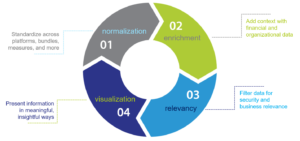Trim Cloud Fat to Reduce Your ‘Waste Line’
Who doesn’t love the cloud? You have to enjoy the agility and ability to spin up resources at the drop of a credit card, as well as the way you can easily scale resources up and down, at will to match demand.
On the other hand, it’s easy to have too much of a good thing. That’s how you end up with ‘Cloud Bloat.’ And, ‘bloat’ happens when you consume resources you don’t really need. But instead of expanding your waist line, you’re expanding your “waste line” – in fact, research shows that up to 30 percent of cloud spend can be a waste. It comes in the form of provisioning too many services or worse again, leaving services turned-on that aren’t being consumed.
Most businesses rely on the monthly bill from their cloud provider(s) to track cloud usage, and this can pose problems. Cloud bills are in technical terms, rather than terms that make sense to your business. They are also after-the-fact, long past the point of enabling you to react to a problem in any timely fashion, and lack the historical context required to pinpoint problems or plan for future spend. While most cloud providers offer some sort of tagging capability that enables customers to categorize resources, compliance and consistency is difficult to enforce, making it hard to understand who used which resources and at what cost.
With Infrastructure-as-a-Service (IaaS) and Platform-as-a-Service (PaaS) growing as much as 36 percent YoY, the potential for cloud waste is enormous. Cloud makes it easy to spend without governance and control. With per unit costs so low and priced by the hour, how could they possibly add-up to tens of thousands of dollars each month? But they do.
How do you Prevent Cloud Waste?
There are many different sources of waste, but some of the most common include purchasing oversized virtual machines (VMs), leaving VMs turned on when they are no longer needed, using expensive storage for infrequently accessed data, or just spinning up unauthorized resources (aka Shadow IT).
As you adopt more cloud services, and spend increases, managing cloud costs becomes a much larger and critical task. You need to consider how the data is to be used, how often, and by whom, in addition to the factors below:
- Which cloud platform(s) are used or planned?
- Public cloud, private cloud, multi- or hybrid cloud?
- What are our reporting requirements?
- Showback, chargeback, billing?
- Do we have customizable reports, dashboards for business users?
- How much data do we have?
- How accurate does the data need to be?
- Do we need “real-time” results?
- What is our budget and how does it compare to labor costs?
The diagram below illustrates four steps required to transform your data into meaningful intelligence, otherwise known as Cloud Analytics: normalization, enrichment, relevancy and visualization.
- NORMALIZATION
Normalizing data into common buckets and units of measure provides more holistic and useful analytics that ultimately drive better decisions.
- ENRICHMENT
One of the key factors in data transformation is the ability to map your cloud data to organizational and financial information to provide business context that matters to you.
Tags are another key component in the data transformation process and are offered by most cloud providers. However, the effectiveness of tags is limited by the people and processes put in place to enforce them and often result in missing, inconsistent or just plain incorrect tagging of resources.
- RELEVANCE
In order to trim the cloud fat, your cloud consumers need fast access to relevant information so they can see where they’re spending and trim where necessary. Role-based permissions allow you to apply filters and also protect company data by restricting access to confidential information.
- VISUALIZATION
Raw data or data in spreadsheets lacks the context and the visual “ah-hah!” you need to optimize your cloud spend and make better business decisions. Different roles require different levels of information.
A picture’s worth a thousand words – or, in the case of the cloud, hundreds of thousands of rows of data. The amount of data is growing exponentially, with more than 2.5 quintillion bytes of data being produced every day. It’s no wonder the BI and analytics market is predicted to reach $16.9B this year.
Optimization Plan of Attack
Every business is different, so it’s best to start out small and build from there. Begin with the highest cost resources or the resources that have the greatest impact on your business. If CPU performance is mission-critical for your customer-facing apps, then target VM utilization first. If keeping costs under budget for a particular project is your main objective, then target costs by project.
To help your business better formulate a plan of attack, here are 12 quick tips for helping manage cloud spend:
- If you have more than $20,000 of cloud spend per month, ditch the spreadsheet and automate
- Collect cloud usage and spend on a daily basis
- Normalize data across cloud platforms, service bundles and units of measure to see everything in a single, holistic manner
- Think of the end results you want first, and work backwards to identify users, visualizations and data requirements
- Add both organizational and financial context to your cloud data to give business meaning
- Eliminate any IT bottleneck - give end users self-service reporting access. Save time and money
- Develop use cases to ensure your tagging strategy considers both financial and operational goals
- People and processes are not enough to enforce consistent tagging – technology must be used to add, correct or transform tags
- Data filtering should be enforced to ensure both relevancy and confidentiality
- Use the right visualization chart for the story you’re trying to tell with your data
- Implement multiple levels of control to ensure usage and spending stays within pre-set thresholds
- Focus first on the areas of greatest spend and/or the areas of greatest impact to the business
About the Author
Deirdre Mahon is a marketing executive with over two decades of experience at start-up, fast-growth, and large public organizations managing diverse teams with a focus on building new market segments. She joined Cloud Cruiser after a four-year stint at RainStor as VP Marketing & Alliances.












